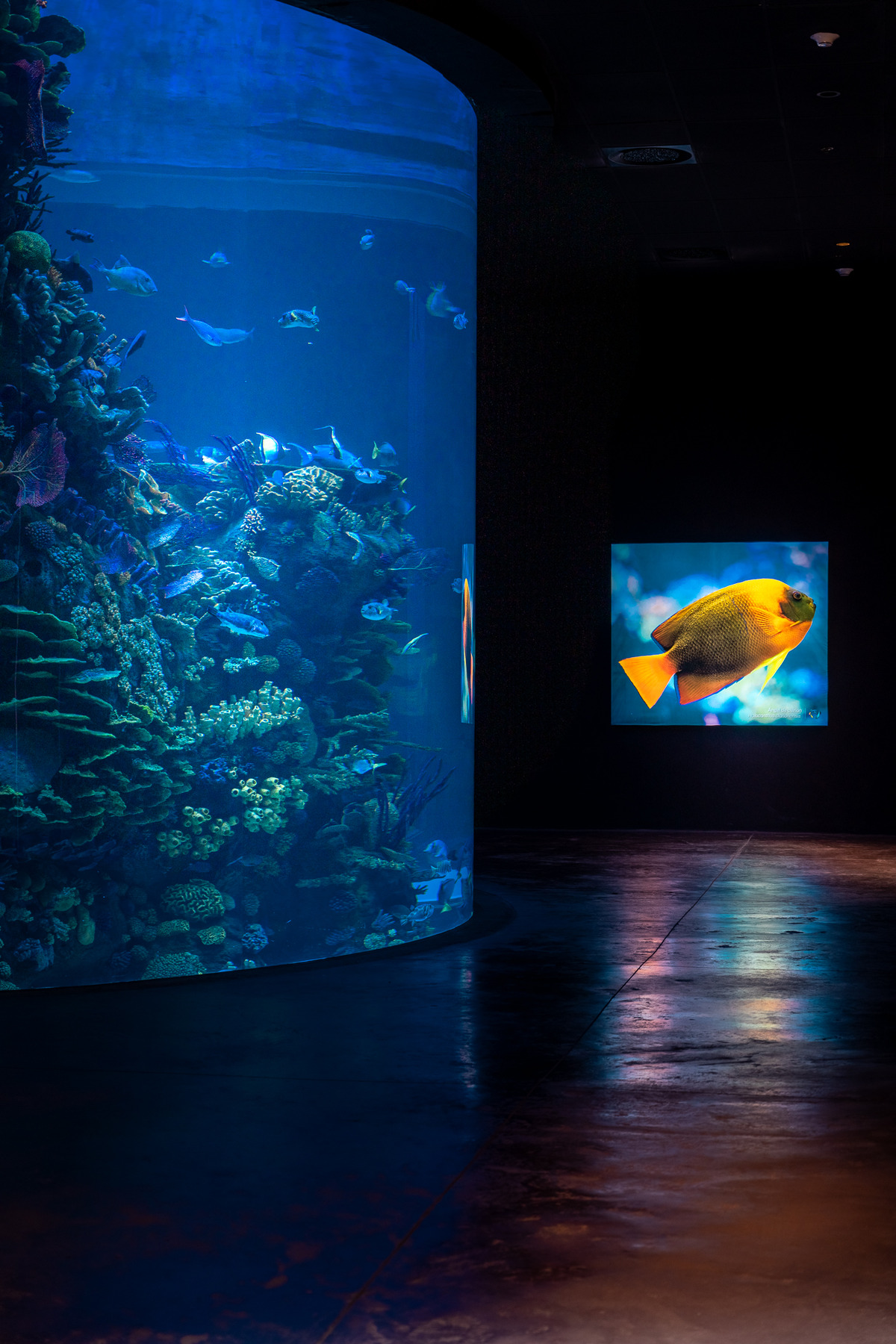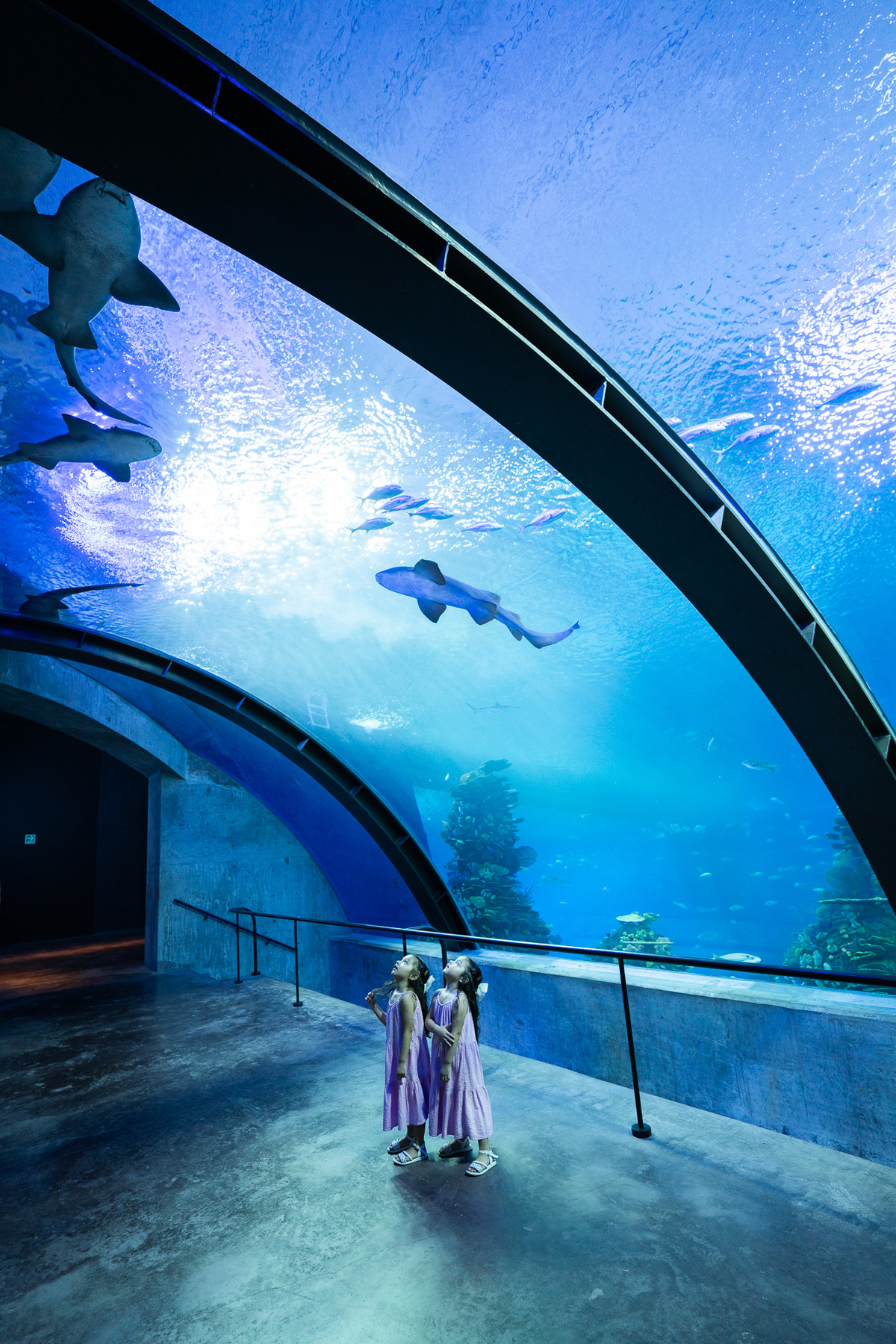
Gran Acuario Mazatlán
The colonial port city of Mazatlán is known for many things. For starters, it’s the shrimp capital of Mexico. The 13-mile Malecon (seaside boardwalk), venue for a lively pre-Lenten Carnival, is considered one of the longest in the world. El Faro, which crowns a Gibraltar-like rock that rises from the sea, is ranked among the tallest natural lighthouses in the world.
Recently added to the list of the city’s attractions is the Gran Acuario Mazatlán, the largest aquarium in Latin America and the only one in the world dedicated to the Sea of Cortéz. Opened in May 2023 following four years of construction, the 26,000-square-meter, $99.3 million (USD) development, a public-private venture, is best in class. The family-friendly aquarium, a celebration of the unique wildlife and marine ecosystems in the Sea of Cortéz, is the centerpiece of the city’s 75-acre Central Park. Focused on the preservation of seas and coastlines, the Gran Acuario Mazatlán combines unrivaled architecture, majestic exhibits, and state-of-the-art conservation technology.

Designed by Mexican architect Tatiana Bilbao, whose works often merge geometry with nature, the three-story aquarium houses 260 marine species. The showcase attraction is the great Oceanic habitat, a 2.8-million-liter exhibition tank with a window that is more than 42 feet tall by 23 feet wide. Overall, the aquarium’s exhibition tanks hold approximately 1.2 million gallons of water. In addition to the colossal fish and coral reef tanks, the facility boasts a large lake filled with nearly 53 million gallons of water.Among the marine animals on display, all native to the Sea of Cortéz, are 36 species of mammals (including sea lions), 31 cetaceans (including dolphins and other aquatic mammals), five of the seven global species of sea turtles, as well as sharks, seahorses, jellyfish and manta rays.

“The abundant marine fauna and the crystalline waters that bathe the coasts of the states of Baja California, Sonora and Sinaloa led (French oceanographer) Jacques Cousteau to call the Sea of Cortéz ‘the aquarium of the world,’” said Miguel Torruco Marques, Mexico’s Minister of Tourism.
He pointed out that the Gran Acuario Mazatlan brings many benefits to the city, such as an increase in the average stay of tourists and higher occupancy levels. The aquarium has already generated a greater economic spillover throughout the value chain of tourism activity, especially to small and medium-size businesses.
“With actions like this, we continue the path of making tourism a tool for social reconciliation,” Marques stated when the aquarium made its debut. “This great facility will place Mazatlán, Sinaloa and Mexico in the ‘showcase’ of world tourism.”
The recent debut of snorkeling and diving experiences at the Gran Acuario Mazatlán has added an exciting new interactive dimension to the already popular tourist attraction and research institute.

Visitors can now swim with sharks and learn about hundreds of pelagic species both large and small in a safe environment. These new attractions have been an instant success with adventurous visitors.
The minimum age to enjoy the snorkeling experience is 12 years old; cameras and video adapted for underwater use are permitted. For the scuba diving experience, a patron must be a certified diver. Pictures and videos can be taken as per the divemaster’s approval.
At an additional cost, explorers can be part of the special Calypso tour. During this behind-the-scenes experience, participants meet with marine biologists and animal care experts to learn about the impressive equipment that keeps the aquarium‘s denizens alive and healthy.
The facility’s Humboldt penguins and California sea lions exhibits, Introduced last year, have been a big hit with visitors. The penguins are cute, whimsical little birds, while the sea lions, a very social species and the aquarium’s unofficial ambassadors, entertain guests with their boundless energy and amazing skills.

Approximately one million people visited the aquarium during its first year of operation, far exceeding expectations. Sinaloa Tourism Minister Estrella Palacios Dominguez said the sparkling new facility marks a “before and after” in the history of Mazatlán as a tourist destination.
Exuding a cathedral-like grandeur based on its size and scale, the aquarium’s interactive exhibits (touch tanks with rays and starfish) promote awareness of regional biodiversity. There are 19 exhibition spaces, four interior courtyards, and a 240-person auditorium for educational and entertainment programming. Smaller meeting rooms are available for conferences.
The aquarium’s lush botanical garden has a space dedicated to Jacques Cousteau, the pioneering underwater explorer and scuba tank inventor who’s highly revered throughout western Mexico for the groundbreaking discoveries he made in the 1960s.

Outside the edifice, indigenous plants and colorful flowering vines hang from the aquarium’s terraces, roofs and tall concrete walls, enhancing the building’s appearance as an ancient, long-forgotten ruin. “It’s a place where the sea and terrestrial nature encounter architecture and the human world,” said Bilbao, the aquarium’s architect. One interesting feature is that the ocean’s bottom-dwelling species are found at the lowest level of the aquarium, while species that live in the middle depths or near the water’s surface are found on higher floors.
The aquarium’s spacious terraces, planted with regional vegetation, enable visitors to take a break from touring the exhibits to enjoy Mazatlán’s balmy weather. In addition, Casa Guacamaya is a sheltered space that houses a diverse array of beautiful birds, such as parakeets, parrots, macaws and many other tropical species. By simulating a natural habitat, these colorful birds live safely and under optimal conditions. Early arrivals can enjoy the free flight of the macaws, a daily part of their routine.


The aquarium is staffed with knowledgeable guides, many of them bilingual. The Gran Acuario Mazatlán was designed and built to attract an international audience in addition to domestic visitors.
The aquarium has quickly become a leading scientific research center, with resources dedicated to the study of marine life and ecosystems, climate change, and ocean health. (A portion of the facility’s revenue has been pledged to preserve biodiversity in the Sea of Cortez). The aquarium also functions as an educational hub, delighting and inspiring the next generation of marine biologists and oceanographers with immersive shows and thought-provoking exhibits
Through the Coordination of Education for Conservation, the aquarium offers tours, talks and various educational activities related to the conservation of marine life. These experiences are adapted to all education levels. The staff is trained to offer a fun and enlightening experience to visitors of all ages.
The Gran Acuario Mazatlán is the first public-private partnership project in Mexico’s tourism sector. Ernesto Coppel, founder of Pueblo Bonito Resorts and a native of Mazatlán, played a pivotal role in realizing this ambitious project, generating 60% of the funding for the aquarium, which replaced a more modest facility. (As an aside, Coppel was a recent judge on “Shark Tank Mexico”).

Additional funds for the aquarium were sourced from the national infrastructure fund (Fonadin), the national fund for tourism (Fonatur), the National Bank of Foreign Trade (Bancomext), the National Works and Public Service Bank (Banobras), and BanCoppel, a private banking firm. Major contributors also included the Government of Sinaloa and the City of Mazatlán. The public-private development underscores a joint commitment to science, education and tourism.
Secretary of Tourism Marqués stressed that Gran Acuario Mazatlán is a long-cherished dream. “Having an aquarium of international stature in this port supports the identity of Mazatlán and generates well-being through economic development, culture and science,” he said. “The aquarium’s research programs will help preserve the rich biodiversity of the Sea of Cortéz and will promote sustainable practices for all aquatic animals in our region.”
Craving more destinations? Check out our other articles here.

